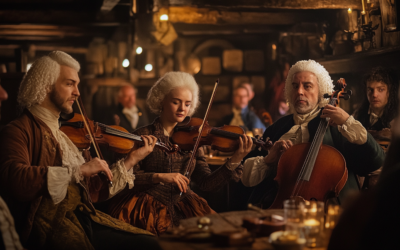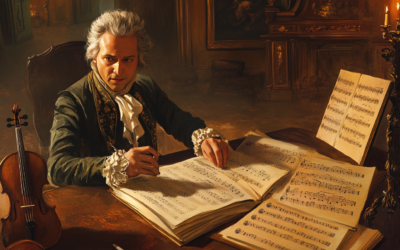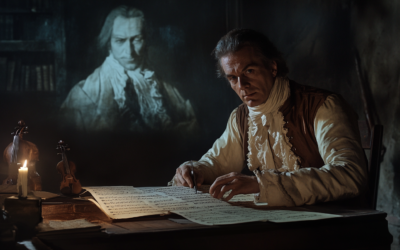A Misleading Legacy
The Questionable Attribution of Mozart’s Offertorium K.34
The Offertorium K.34, Scande Coeli limina, has long been attributed to Wolfgang Amadeus Mozart, but the evidence supporting this claim is far from reliable. Lacking an autograph manuscript and based solely on a questionable 19th-century copy found in Salzburg, the authenticity of this work has come under scrutiny. To make matters worse, the supposed performance date of 21 March 1767 at Seeon Abbey in Bavaria is based on nothing more than speculation from much later sources, with no records placing the Mozart family in the area at that time.
The Offertorium also presents problems in its musical structure and text, which raises questions about the skill of the composer behind it—hardly what one would expect from someone of Mozart’s calibre. Could this be yet another case of later scholars inflating his legacy by attributing lesser works to his name?
This article delves into the historical confusion, Latin blunders, and questionable cataloguing that surround this piece, inviting us to reconsider whether Offertorium K.34 truly belongs to Mozart’s body of work or is just another case of misplaced authorship.
Mozart: The Fall of the Gods
This book compiles the results of our studies on 18th-century music and Mozart, who has been revered for over two centuries as a deity. We dismantle the baseless cult of Mozart and strip away the clichés that falsely present him as a natural genius, revealing the contradictions in conventional biographies. In this work, divided into two parts, we identify and critically analyze several contradictory points in the vast Mozart bibliography. Each of the nearly 2,000 citations is meticulously sourced, allowing readers to verify the findings. This critical biography of Mozart emerges from these premises, addressing the numerous doubts raised by researchers.
"Attributing Offertorium K.34 to Mozart is not just misleading, it reflects the careless methods used by 19th-century scholars to inflate his legacy."
Mozart: The Fall of the Gods
The Questionable Attribution of Mozart’s Offertorium K.34: A Misleading Legacy
Offertorium K.34, Scande Coeli limina, is a work attributed to Wolfgang Amadeus Mozart, yet its authenticity is highly debatable. Allegedly written for soprano, choir (SATB), two trumpets, timpani, two violins, basso, and organ, the piece is composed in C major. It consists of two movements: an aria for soprano (Andante) and a choral response (Cara o pignora, Allegro). However, the entire attribution rests on fragile, late evidence and lacks any solid foundation.
Spurious and Muddled Attribution
The Offertorium’s connection to Mozart is based solely on a suspicious 19th-century copy found in Salzburg, long after Mozart’s death. Its only claim to authenticity? A crude label affixed to the cover, stating “by Wolfgang Mozart.” No autograph manuscript exists, and there is no verifiable evidence linking this work directly to the composer. Such a posthumous attribution raises red flags, particularly when the piece surfaced during an era when attaching Mozart’s name to anything could inflate its value and prestige.
The alleged performance date—21 March 1767 at Seeon Abbey in Bavaria for the Feast of Saint Benedict—is another shaky detail. This claim originates from another copy of the score, which appeared in the mid-19th century, even later than the Salzburg version. Wyzewa and Saint-Foix, two eager biographers, speculated this date simply because it coincides with Saint Benedict’s feast day. Yet, there’s no evidence placing the Mozart family in Bavaria on that date, casting further doubt on this supposed performance. This confusion only underscores how arbitrary and unreliable these claims are.
Misguided Catalogues
The Offertorium appears as K.34 in the Köchel catalogue of Mozart’s works, but it is also listed as WSF 44 in the Wyzewa-Saint-Foix catalogue. The discrepancies between these catalogues are symptomatic of the broader issue: Mozart’s name has been haphazardly attached to numerous works, often without solid proof. Poggi and Vallora, in their catalogue, mention that Leopold Mozart was supervising his son’s education at this time. Yet, if this piece is any indication of such ‘education’, it is hardly impressive.
Latin Blunders and Liturgical Faux Pas
What further discredits this work is the poor Latin in the text. The piece begins with the soprano calling upon the soul of Saint Benedict—an odd choice for a liturgical work dedicated to the saint himself. The choir then responds as if it were Saint Benedict speaking. Such a glaring mishandling of ecclesiastical Latin would not have gone unnoticed by the Benedictine monks who were well-versed in the language. Could this be yet another clue that this work was not crafted by a skilled composer, let alone one with the training attributed to Mozart?
Conclusion
The Offertorium Scande Coeli limina is another example of how easily works have been falsely attributed to Mozart, with little more than speculation and posthumous tampering. The lack of an autograph and the weak historical claims surrounding its performance should make us question its authenticity, not blindly accept it as another work of ‘Mozart’.
As discussed by Luca Bianchini and Anna Trombetta in Mozart: La caduta degli dei (2018), this case illustrates the broader problems in Mozart scholarship, where unfounded attributions are accepted without proper scrutiny. For a detailed examination of this Offertorium, see pages 295-296 of their book.
You May Also Like
Mozart’s Quartet of Lodi: A Dated Work with Many Influences
Mozart’s Quartet of Lodi is often praised as an early masterpiece. But was it really his own work?
The Hidden Influence of Joseph Boulogne, Chevalier de Saint-George
Joseph Boulogne, known as the “Black Mozart”, was shaping the future of music while Mozart was still struggling for recognition in Paris. But history has buried the significant influence Saint-George had on Mozart’s career, erasing his pioneering style from the narrative.
Mozart’s Violin Pieces: Substitutes for Failed Movements?
Despite revisions, Mozart’s violin concertos remain flawed, while his minor pieces, K.261 and K.373, surprisingly garner more attention in his correspondence than his major works.
The Questionable Origins of Mozart’s Violin Concertos
Are Mozart’s violin concertos truly original? This article explores the possibility that the Czech composer Josef Mysliveček played a far larger role in their creation than previously acknowledged.
The Kolb Concerto: A Mozartian Mirage?
The Kolb Concerto’s dubious origin and poor musical quality expose yet another myth in the Mozartian canon. If this is the work of a genius, then perhaps we’ve been fooled for centuries.
The Adélaïde Deception: Mozart’s “Lost” Violin Concerto and the Art of Musical Forgery
In the early 20th century, the “discovery” of Mozart’s sixth violin concerto in Paris created a sensation. Dubbed the Adélaïde Concerto and supposedly written for Madame Adélaïde of France, it was hailed as a testament to Mozart’s genius. However, as the story unfolds, it becomes clear that this masterpiece was not the work of the child prodigy but rather a carefully orchestrated hoax by Marius Casadesus. Despite its unmasking as a forgery, the concerto continues to captivate audiences, raising questions about authenticity and the music industry’s willingness to deceive for profit.







